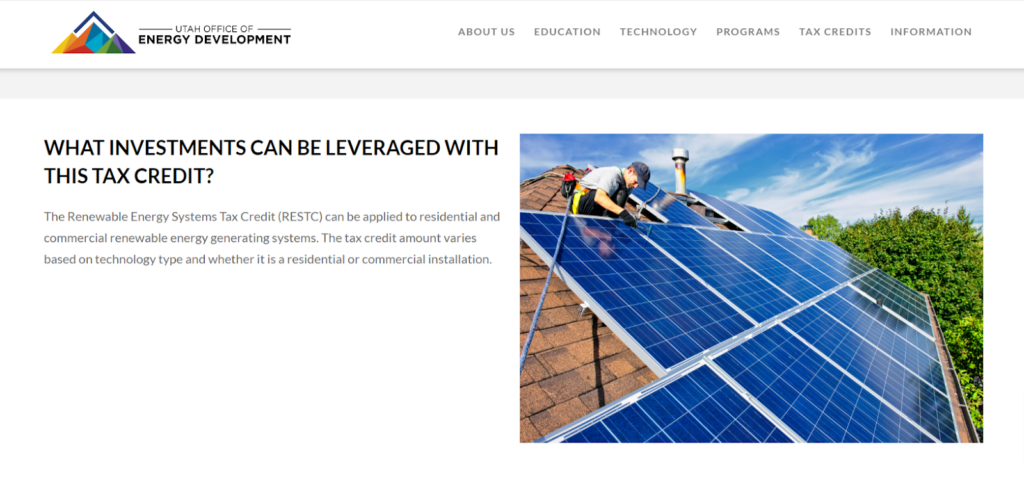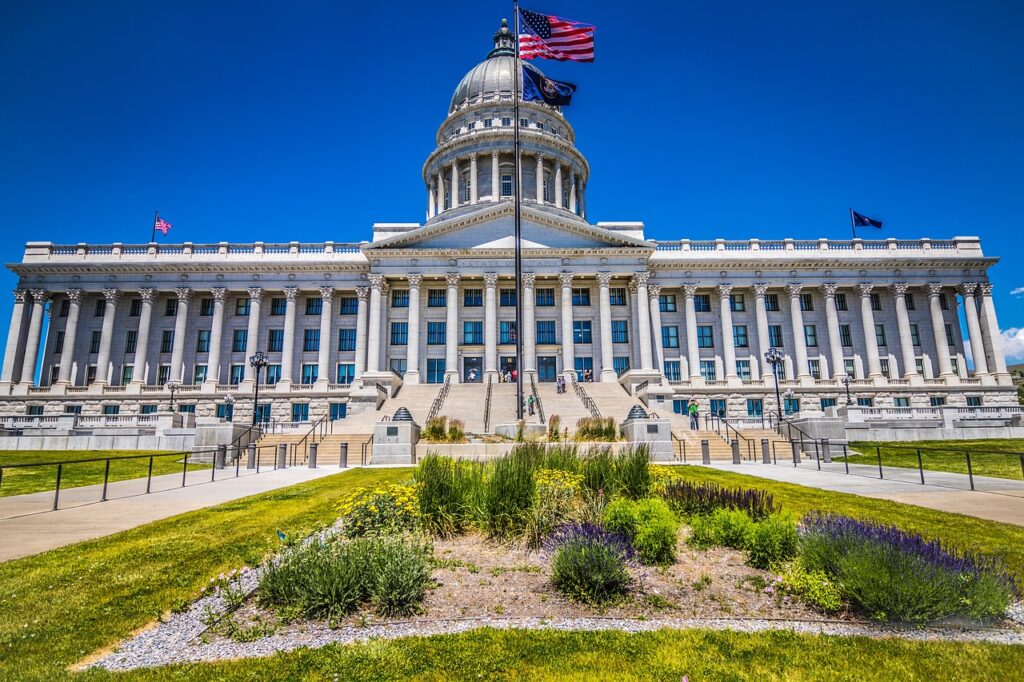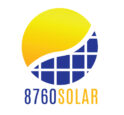
Utah is definitely a good spot for solar. The state enjoys over 230 days worth of sunshine each year, which is higher than the national average.
Utah is also doing well compared with other states, as it currently ranks 13th for the uptake of solar energy. Right now, 12.35% of the state’s electricity comes from solar – enough to power 527,842 homes.
In short, Utah gets a thumbs up for its efforts in sustainable energy.
But what is its government doing to entice people to make the move to solar? Since it’s an expensive investment, many governments are lightening the load with tax credits and other incentives.
Let’s take a look at what Utah has in store.
In a Nutshell
- The renewable energy systems tax credit is a Utah-wide scheme that provides a 10% or $50,000 tax credit on the cost of commercial installations.
- The renewable energy systems tax credit is available for residential solar installations but is ending at the end of 2023.
- Utah has net metering in place where a monetary credit is applied to monthly energy bills in exchange for solar-generated electricity.
- Rocky Mountain Power offers rebates for installing certain solar batteries.
- Utah residents can take advantage of the US-wide REAP grant and/or 30% federal tax credit.
Utah Solar Incentives
We’re happy to report that Utah does have a few solar incentives available.
Renewable Energy Systems Tax Credit (RESTC)

The RESTC is great if you are planning a commercial installation (to run your business) and not so great if you are a residential customer.
Unfortunately for residential solar systems, this incentive is being phased out and will end on January 31st, 2023. Up until then, a tax credit can be had, which equates to either 25% of the cost of the installation or $400 – whichever is the lesser amount (in pretty much all cases it’s going to be $400).
This used to be better. This incentive has run since 2018 and the credit amount started at $1,600 max but dropped in subsequent years to $800 in 2022 and then $400 in 2023.
It’s a shame this is ending as it was a pretty decent incentive on top of the US-wide tax credits available.
If you’re installing a solar system for commercial purposes, however, you can relax. The RESTC credit is not ending for you!
Plus, it’s a really good amount. The tax credit is calculated as 10% of the eligible system cost or $50,000, whichever is less. Therefore, you will get the full 10% on solar systems costing up to $500,000. Anything over $500,000 will get a $50,000 credit.
And even better, there’s no indication of this ending in 2024 or beyond, so you don’t have to rush to get solar installed to take advantage.
To apply for it, you need to set up an account here and pay a nonrefundable $15 application fee. Once you do, you will receive the necessary TC-40E tax form to complete.
Utah Net Billing

What you can get in return for sending your excess solar energy to the grid differs by state. We’re pleased to report that Utah has had a net billing policy in place since 2002, which means you can get credits for every kWh worth of solar-generated energy that you provide to the grid.
Utah’s largest utility provider – Rocky Mountain Power – provides net billing to customers with solar. To qualify, systems must be 2 MW or smaller for non-residential and 25 kW or smaller for residential.
The amount you get for each kWh depends on the time of year:
- June through September inclusive: 5.636¢ per kWh
- October through May inclusive: 4.745¢ per kWh
Credits roll over each month. However, unused credits expire on March 31st of each year and the “clock” is reset.
While Rocky Mountain Power serves 80% of the state, there are some smaller cooperative utility companies operating in Utah that also provide net billing. However, their rates are not disclosed, although most of them stipulate that the solar system’s size must be 25 kWh or less.
Rocky Mountain Power Wattsmart Battery Program

Utah residents who use Rocky Mountain Power as their utility provider and invest in (qualifying) solar batteries can enroll in the Wattsmart Battery program and get an upfront rebate as well as an ongoing yearly rebate.
The amount you get depends on the capacity of the battery and consists of:
- Upfront cash payment rebate of $400 per kW (based on a 4-year commitment)
- Annual energy bill credit of $15 per kW
So, if you install a 6 kW battery, you’ll get 6 x $400 = $2,400 rebate upfront, then
6 x $15 = $90 annual bill credit.
The annual bill credit is divided across your monthly payments, so in this case, $90/12 would result in a $7.50 reduction in your monthly bills.
Batteries must be installed by an approved installation company, and only select batteries are eligible:
- Sonnen: Core, Core+, Eco, and EcoLinx
- SolarEdge
- Fortress Power Envy True: 8 kW and 12kW battery systems
- Torus Station Core: 8kW, 16kW, and 24kW inverters
If you install more than one battery, Rocky Mountain Power requires preapproval for the scheme.
As a warning, this scheme might not be for everyone. By participating, you hand over control and management of your battery to Rocky Mountain Power. They have the power to turn it on and off whenever they want and can use any of the battery’s stored energy according to their needs.
Plus, you have to commit for four years, so it can end up being a lengthy agreement if it doesn’t work out for you.
US-Wide Solar Incentives
Next, let’s check out what federal incentives are available to Utah residents. Below, you will find an overview. If you want the full details, you can head to this article that goes into things in a bit more depth.
USDA REAP Grant

The USDA’s Rural Energy for America Program (REAP) is available exclusively to farmers and rural or agricultural businesses. It forms part of the Inflation Reduction Act and provides a healthy grant toward the cost of a solar system.
Successful applicants get:
- A grant of up to 50% of the cost of a solar installation
- Grants are capped at $1 million
- Loans for up to 75% of the cost can also be provided where REAP will act as guarantor
We will say that the application process is a pain and can be lengthy. However, 100% of 8760 Solar’s clients who applied for the funding have been successful. And by now, we’re extremely well-versed in how to deal with REAP applications, so we can help you every step of the way.
Currently, the application windows for REAP are:
- December 31, 2023
- March 31, 2024
- June 30, 2024
- September 30, 2024
REAP will continue after September 2024, however, the grant and loan amounts or the terms of the incentive could change.
There are qualifying criteria that must be met. As we already mentioned, you must be a farmer or rural or agricultural business. Additionally:
- Agricultural operations must account for at least 50% of gross annual income
- Your business must conform to the size standards of the Small Business Administration (13 CFR 121) and located in an area with a population of 50,000 or less
- Your business must be one of the following:
- A Sole Proprietorship, Partnership, or Corporation
- A tribal corporation or business
- A cooperative
- An electric utility
- Your business has no delinquent federal taxes, debt, judgment, or debarments currently outstanding
Click here to access the application forms.
Federal Solar Tax Credit
Both residential and business solar installations qualify for the federal solar tax credit.
You get a 30% investment tax credit (ITC) used to reduce your income tax liability.
This amount is calculated as a percentage of the cost of the installed system.
For example, a $500,000 system will generate a tax credit worth $150,000.
- Credits can be backdated for three years
- Credits can carry forward for five years
To get the tax credit, installations must:
- Have been placed in service in 2022 or later
- Begin construction before 2033
- Be installed in the US
- Contain new or limited previous-use equipment
- Not be leased to a tax-exempt entity
Additional bonus credits for commercial/business installations can also be obtained if further criteria are met:
To benefit from the tax credit, complete form 8962 and attach it to your tax return.
Should I Get Solar if I Live in Utah?

We think that Utah is a great state to get solar, with plenty of sunshine and numerous benefits and incentives.
While it’s a shame that the renewable energy systems tax credit for residential solar is ending, we don’t know what else might be around the corner. 2024 might have some new incentives up its sleeve, so we will be sure to keep a keen eye on what’s going on.
Meanwhile, the incentives for business/commercial solar are excellent! In addition to the 10% renewable energy systems tax credit, you can get your 30% ITC credit.
Now imagine that your farming business qualifies for a 50% REAP grant too. That’s 90% of the cost of your solar installation covered right away – and that’s before you start saving on your energy bills!
Our mission at 8760 Solar is to bring the benefits of solar energy to farming businesses in Colorado, Utah, and the surrounding states. If you want to understand more about solar energy, our installation process, and the available incentives, text “READY” to 719 470-0254 or get in touch via email: sales@8760solar.com.
We’re looking forward to talking solar with you!
Frequently Asked Questions
Does Utah Have Solar Incentives?
Utah has a renewable energy systems tax credit in place, which provides a 10% or $50,000 (whichever is lesser) tax credit for commercial solar systems. This scheme is available for residential solar systems too but is capped at $400 and is ending on December 31st, 2023 (Commercial solar will still be able to claim the credit in 2024).
Is Utah a Good Place for Solar Panels?
Utah has over 230 days of sunshine each year, making it a great state for solar. Utah currently ranks 13th out of all states for solar energy and has incentives including a tax credit and net billing, which makes installing solar even more advantageous.
How Much Are Solar Panels in Utah?
According to EnergySage, the average cost of a 5 kWh solar system in Utah is just over $13,000. However, the true cost very much depends on the type and size of the solar system you have and where it is installed.
What Is the Low-Income Solar Program in Utah?
There is no low-income solar program currently available in Utah.
